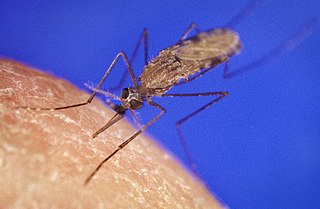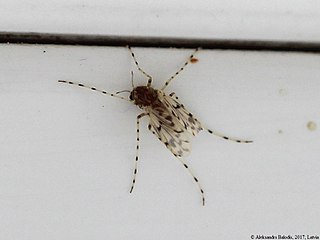Species
- F. lacustris Kieffer, 1924 [1]
| Fleuria | |
|---|---|
| Scientific classification | |
| Kingdom: | |
| Phylum: | |
| Class: | |
| Order: | |
| Suborder: | |
| Infraorder: | |
| Superfamily: | |
| Family: | |
| Subfamily: | |
| Tribe: | |
| Genus: | Fleuria Kieffer, 1924 |
Fleuria is a genus of European non-biting midges in the subfamily Chironominae of the bloodworm family Chironomidae.

The Culicomorpha are an infraorder of Nematocera, including mosquitoes, black flies, and several extant and extinct families of insects. They originated 176 million years ago, in the Triassic period. There are phylogenetic patterns that are used to interpret bionomic features such as differences in the nature of blood-feeding by adult females, daytime or nighttime feeding by adult females, and occurrence of immature stages in aquatic habitats.

A midge is any small fly, including species in several families of non-mosquito nematoceran Diptera. Midges are found on practically every land area outside permanently arid deserts and the frigid zones. Some midges, such as many Phlebotominae and Simuliidae, are vectors of various diseases. Many others play useful roles as prey for insectivores, such as various frogs and swallows. Others are important as detritivores, and form part of various nutrient cycles. The habits of midges vary greatly from species to species, though within any particular family, midges commonly have similar ecological roles.

The Chironomidae comprise a family of nematoceran flies with a global distribution. They are closely related to the Ceratopogonidae, Simuliidae, and Thaumaleidae. Many species superficially resemble mosquitoes, but they lack the wing scales and elongated mouthparts of the Culicidae.

Chaoboridae, commonly known as phantom midges or glassworms, is a family of fairly common midges with a cosmopolitan distribution. They are closely related to the Corethrellidae and Chironomidae; the adults are differentiated through peculiarities in wing venation.

The Chironomoidea are a superfamily within the order Diptera, suborder Nematocera, infraorder Culicomorpha. This superfamily contains the families Chironomidae, Ceratopogonidae, Simuliidae, and Thaumaleidae.

Nepenthesinfauna are the organisms that inhabit the pitchers of Nepenthes plants. These include fly and midge larvae, spiders, mites, ants, and even a species of crab, Geosesarma malayanum. The most common and conspicuous predators found in pitchers are mosquito larvae, which consume large numbers of other larvae during their development. Many of these animals are so specialised that they cannot survive anywhere else, and are referred to as nepenthebionts.
Arctodiamesa is a genus of non-biting midges in the subfamily Diamesinae of the bloodworm family Chironomidae.

Metriocnemus is a genus of non-biting midges in the subfamily Orthocladiinae of the bloodworm family Chironomidae.
Smittia is a genus of European non-biting midges in the subfamily Orthocladiinae of the bloodworm family (Chironomidae).

Chironominae is a subfamily of midges in the non-biting midge family (Chironomidae).

Chironomini is a tribe of midges in the non-biting midge family (Chironomidae).
Zavrelia is a genus of European non-biting midges in the subfamily Chironominae of the bloodworm family Chironomidae. The genus is named in honour of Jan Zavřel.
Buchonomyia is the only extant genus of the subfamily Buchonomyiinae of the non-biting midge family Chironomidae. There are three known extant species and one fossil species in the genus: Members of the genus are parasitic of psychomyiid caddisflies.

Tanypodinae is a subfamily of midges in the non-biting midge family (Chironomidae). The larvae are generally carnivorous and their mouthparts are adapted for predation on small invertebrates although 1st and 2nd instar larvae also feed on algae.

Diamesinae is a subfamily of midges in the non-biting midge family (Chironomidae).
Diamesini is a tribe of midges in the non-biting midge family (Chironomidae).
Pseudodiamesa is a genus of non-biting midges in the subfamily Diamesinae of the bloodworm family Chironomidae.
Pagastia is a genus of non-biting midges in the subfamily Diamesinae of the bloodworm family Chironomidae.
Afrozavrelia is a genus of European non-biting midges in the subfamily Chironominae of the bloodworm family Chironomidae that are closely related to Zavrelia.
Aagaardia is a genus of fly in the Chironomidae family. Aagaardia has been found in Finland, the mainland of Norway and Russia.